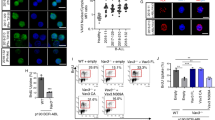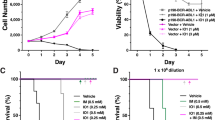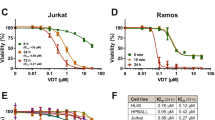Abstract
Aim:
To investigate a novel function of proto-oncogene Vav1 in the apoptosis of human leukemia Jurkat cells.
Methods:
Jurkat cells, Jurkat-derived vav1-null cells (J.Vav1) and Vav1-reconstituted J.WT cells were treated with a Fas agonist antibody, IgM clone CH11. Apoptosis was determined using propidium iodide (PI) staining, Annexin-V staining, DNA fragmentation, cleavage of caspase 3/caspase 8, and poly (ADP-ribose) polymerase (PARP). Mitochondria transmembrane potential (ΔΨm) was measured using DiOC6(3) staining. Transcription and expression of the Bcl-2 family of proteins were evaluated using semi-quantitative RT-PCR and Western blot, respectively. Bcl-2 promoter activity was analyzed using luciferase reporter assays.
Results:
Cells lacking Vav1 were more sensitive to Fas-mediated apoptosis than Jurkat and J.WT cells. J.Vav1 cells lost mitochondria transmembrane potential (ΔΨm) more rapidly upon Fas induction. These phenotypes could be rescued by re-expression of Vav1 in J.Vav1 cells. The expression of Vav1 increased the transcription of pro-survival Bcl-2. The guanine nucleotide exchange activity of Vav1 was required for enhancing Bcl-2 promoter activity, and the Vav1 downstream substrate, small GTPase Rac2, was likely involved in the control of Bcl-2 expression.
Conclusion:
Vav1 protects Jurkat cells from Fas-mediated apoptosis by promoting Bcl-2 transcription through its GEF activity.
Similar content being viewed by others
Log in or create a free account to read this content
Gain free access to this article, as well as selected content from this journal and more on nature.com
or
References
Katzav S, Martin-Zanca D, Barbacid M . vav, a novel human oncogene derived from a locus ubiquitously expressed in hematopoietic cells. EMBO J 1989; 8: 2283–90.
Movilla N, Bustelo XR . Biological and regulatory properties of Vav-3, a new member of the Vav family of oncoproteins. Mol Cell Biol 1999; 19: 7870–85.
Schuebel KE, Bustelo XR, Nielsen DA, Song BJ, Barbacid M, Goldman D, et al. Isolation and characterization of murine vav2, a member of the vav family of proto-oncogenes. Oncogene 1996; 13: 363–71.
Fischer KD, Zmuldzinas A, Gardner S, Barbacid M, Bernstein A, Guidos C . Defective T-cell receptor signalling and positive selection of Vav-deficient CD4+ CD8+ thymocytes. Nature 1995; 374: 474–7.
Turner M, Mee PJ, Walters AE, Quinn ME, Mellor AL, Zamoyska R, et al. A requirement for the Rho-family GTP exchange factor Vav in positive and negative selection of thymocytes. Immunity 1997; 7: 451–60.
Fujikawa K, Miletic AV, Alt FW, Faccio R, Brown T, Hoog J, et al. Vav1/2/3-null mice define an essential role for Vav family proteins in lymphocyte development and activation but a differential requirement in MAPK signaling in T and B cells. J Exp Med 2003; 198: 1595–608.
Cao Y, Janssen EM, Duncan AW, Altman A, Billadeau DD, Abraham RT . Pleiotropic defects in TCR signaling in a Vav-1-null Jurkat T-cell line. EMBO J 2002; 21: 4809–19.
Paccani SR, Boncristiano M, Patrussi L, Ulivieri C, Wack A, Valensin S, et al. Defective Vav expression and impaired F-actin reorganization in a subset of patients with common variable immunodeficiency characterized by T-cell defects. Blood 2005; 106: 626–34.
Prieto-Sanchez RM, Hernandez JA, Garcia JL, Gutierrez NC, San MJ, Bustelo XR, et al. Overexpression of the VAV proto-oncogene product is associated with B-cell chronic lymphocytic leukaemia displaying loss on 13q. Br J Haematol 2006; 133: 642–5.
Hornstein I, Pikarsky E, Groysman M, Amir G, Peylan-Ramu N, Katzav S . The haematopoietic specific signal transducer Vav1 is expressed in a subset of human neuroblastomas. J Pathol 2003; 199: 526–33.
Fernandez-Zapico ME, Gonzalez-Paz NC, Weiss E, Savoy DN, Molina JR, Fonseca R, et al. Ectopic expression of VAV1 reveals an unexpected role in pancreatic cancer tumorigenesis. Cancer Cell 2005; 7: 39–49.
Bartolome RA, Molina-Ortiz I, Samaniego R, Sanchez-Mateos P, Bustelo XR, Teixido J . Activation of Vav/Rho GTPase signaling by CXCL12 controls membrane-type matrix metalloproteinase-dependent melanoma cell invasion. Cancer Res 2006; 66: 248–58.
Zugaza JL, Lopez-Lago MA, Caloca MJ, Dosil M, Movilla N, Bustelo XR . Structural determinants for the biological activity of Vav proteins. J Biol Chem 2002; 277: 45377–92.
Tybulewicz VL, Henderson RB . Rho family GTPases and their regulators in lymphocytes. Nat Rev Immunol 2009; 9: 630–44.
Fischer KD, Kong YY, Nishina H, Tedford K, Marengere LE, Kozieradzki I, et al. Vav is a regulator of cytoskeletal reorganization mediated by the T-cell receptor. Curr Biol 1998; 8: 554–62.
Katzav S . Vav1: an oncogene that regulates specific transcriptional activation of T cells. Blood 2004; 103: 2443–51.
Zhou Z, Yin J, Dou Z, Tang J, Zhang C, Cao Y . The calponin homology domain of Vav1 associates with calmodulin and is prerequisite to T cell antigen receptor-induced calcium release in Jurkat T lymphocytes. J Biol Chem 2007; 282: 23737–44.
Blanchet F, Cardona A, Letimier FA, Hershfield MS, Acuto O . CD28 costimulatory signal induces protein arginine methylation in T cells. J Exp Med 2005; 202: 371–7.
Rathmell JC, Thompson CB . Pathways of apoptosis in lymphocyte development, homeostasis, and disease. Cell 2002; 109: S97–107.
Kong YY, Fischer KD, Bachmann MF, Mariathasan S, Kozieradzki I, Nghiem MP, et al. Vav regulates peptide-specific apoptosis in thymocytes. J Exp Med 1998; 188: 2099–111.
Ramaswamy M, Dumont C, Cruz AC, Muppidi JR, Gomez TS, Billadeau DD, et al. Cutting edge: Rac GTPases sensitize activated T cells to die via Fas. J Immunol 2007; 179: 6384–8.
Tuosto L, Marinari B, Piccolella E . CD4-Lck through TCR and in the absence of Vav exchange factor induces Bax increase and mitochondrial damage. J Immunol 2002; 168: 6106–12.
Vigorito E, Gambardella L, Colucci F, McAdam S, Turner M . Vav proteins regulate peripheral B-cell survival. Blood 2005; 106: 2391–8.
Opalinska JB, Machalinski B, Ratajczak J, Ratajczak MZ, Gewirtz AM . Multigene targeting with antisense oligodeoxynucleotides: an exploratory study using primary human leukemia cells. Clin Cancer Res 2005; 11: 4948–54.
Poppe D, Tiede I, Fritz G, Becker C, Bartsch B, Wirtz S, et al. Azathioprine suppresses ezrin-radixin-moesin-dependent T cell-APC conjugation through inhibition of Vav guanosine exchange activity on Rac proteins. J Immunol 2006; 176: 640–51.
Katzav S . Flesh and blood: the story of Vav1, a gene that signals in hematopoietic cells but can be transforming in human malignancies. Cancer Lett 2007; 255: 241–54.
Koncz G, Kerekes K, Chakrabandhu K, Hueber AO . Regulating Vav1 phosphorylation by the SHP-1 tyrosine phosphatase is a fine-tuning mechanism for the negative regulation of DISC formation and Fas-mediated cell death signaling. Cell Death Differ 2008; 15: 494–503.
Scaffidi C, Fulda S, Srinivasan A, Friesen C, Li F, Tomaselli KJ, et al. Two CD95 (APO-1/Fas) signaling pathways. EMBO J 1998; 17: 1675–87.
Hildeman DA, Zhu Y, Mitchell TC, Bouillet P, Strasser A, Kappler J, et al. Activated T cell death in vivo mediated by proapoptotic bcl-2 family member bim. Immunity 2002; 16: 759–67.
Heckman CA, Mehew JW, Boxer LM . NF-kappaB activates Bcl-2 expression in t(14;18) lymphoma cells. Oncogene 2002; 21: 3898–908.
Bustelo XR . Vav proteins, adaptors and cell signaling. Oncogene 2001; 20: 6372–81.
Tybulewicz VL . Vav-family proteins in T-cell signalling. Curr Opin Immunol 2005; 17: 267–74.
Aghazadeh B, Lowry WE, Huang XY, Rosen MK . Structural basis for relief of autoinhibition of the Dbl homology domain of proto-oncogene Vav by tyrosine phosphorylation. Cell 2000; 102: 625–33.
Yu H, Leitenberg D, Li B, Flavell RA . Deficiency of small GTPase Rac2 affects T cell activation. J Exp Med 2001; 194: 915–26.
Miletic AV, Graham DB, Sakata-Sogawa K, Hiroshima M, Hamann MJ, Cemerski S, et al. Vav links the T cell antigen receptor to the actin cytoskeleton and T cell activation independently of intrinsic Guanine nucleotide exchange activity. PLoS One 2009; 4: e6599.
Yang FC, Kapur R, King AJ, Tao W, Kim C, Borneo J, et al. Rac2 stimulates Akt activation affecting BAD/Bcl-XL expression while mediating survival and actin function in primary mast cells. Immunity 2000; 12: 557–68.
Romero F, Dargemont C, Pozo F, Reeves WH, Camonis J, Gisselbrecht S, et al. p95vav associates with the nuclear protein Ku-70. Mol Cell Biol 1996; 16: 37–44.
Hobert O, Jallal B, Schlessinger J, Ullrich A . Novel signaling pathway suggested by SH3 domain-mediated p95vav/heterogeneous ribonucleoprotein K interaction. J Biol Chem 1994; 269: 20225–8.
Romero F, Germani A, Puvion E, Camonis J, Varin-Blank N, Gisselbrecht S, et al. Vav binding to heterogeneous nuclear ribonucleoprotein (hnRNP) C. Evidence for Vav-hnRNP interactions in an RNA-dependent manner. J Biol Chem 1998; 273: 5923–31.
Houlard M, Romero-Portillo F, Germani A, Depaux A, Regnier-Ricard F, Gisselbrecht S, et al. Characterization of VIK-1: a new Vav-interacting Kruppel-like protein. Oncogene 2005; 24: 28–38.
Houlard M, Arudchandran R, Regnier-Ricard F, Germani A, Gisselbrecht S, Blank U, et al. Vav1 is a component of transcriptionally active complexes. J Exp Med 2002; 195: 1115–27.
Hofmann TG, Hehner SP, Droge W, Schmitz ML . Caspase-dependent cleavage and inactivation of the Vav1 proto-oncogene product during apoptosis prevents IL-2 transcription. Oncogene 2000; 19: 1153–63.
Acknowledgements
This work was supported by grants from the National Natural Science Foundation of China (No 30870128), the Ministry of Science and Technology of China (No 2006CB910103 and 2007CB914800), and the 111 Project (No B08011). The authors would like to thank Drs Keith BURRIDGE and Quan CHEN for providing reagents and helpful discussions.
Author information
Authors and Affiliations
Corresponding author
Additional information
Supplementary figure is available at Acta Pharmacologica Sinica website of NPG.
Supplementary information
Supplementary Figure 1
J.Vav1 cells were susceptible to serum starvation and oxidation induced apoptosis. (DOC 490 kb)
Rights and permissions
About this article
Cite this article
Yin, J., Wan, Yj., Li, Sy. et al. The distinct role of guanine nucleotide exchange factor Vav1 in Bcl-2 transcription and apoptosis inhibition in Jurkat leukemia T cells. Acta Pharmacol Sin 32, 99–107 (2011). https://doi.org/10.1038/aps.2010.185
Received:
Accepted:
Published:
Issue date:
DOI: https://doi.org/10.1038/aps.2010.185



